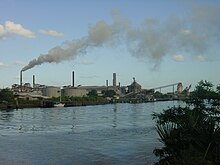User:Mtgravesande/Mining in Guyana
Bauxite
[edit]History
[edit]
The first bauxite mine in the Upper Demerara-Berbice region opened in 1916.[1] At that time, Guyana was still the British colony known as British Guiana.[2] Aluminium became an important resource during the First World War as it was a key material to make aircrafts, and so the global demand for bauxite increased, leading companies to expand development in Guyana.[3] The British government was unwilling to allow Alcan to own the bauxite mines in Guyana because the United States was in control of the Canadian company.[2] The British government was unsuccessful at preventing Alcan from legally owning the bauxite mines in Guyana due to the United States government threatening to cease providing Britain with weapons needed to fight in the war.[2] The British Aluminium Company (B.A.C.) acquired leases to develop bauxite mines on the Christianburg land in Linden following World War I, in order to compete with Demba, who at the time, had control of the majority of bauxite in Guyana.[2] In 1949, the B.A.C's leases were transferred to the Plantation Bauxite Company Ltd. and then transferred to Demba in 1957.[2]
Following Guyana's independence from Britain, the government of Guyana nationalized Demba in 1971.[1]
Environmental impacts
[edit]Bauxite mining has impacted the rainforests in Guyana through deforestation, habitat fragmentation, and soil degradation.[3] Bauxite exports increased by 400% in Guyana during the Second World War, and so the environmental consequences became more severe due to the expanding industry.[3] Tropical forests were cleared to create new mines and the Bayer process left behind red mud and air pollution.[3]
The natural environment of the community Coomacka (Kumaka) in Upper Demerara-Berbice has been altered by bauxite mining.[4] The construction of bauxite mines required sand to be cleared from the land, which eventually led to the formation of a sand beach by the Demerara River.[4] The sand beach has increased flooding in Coomacka.[4]

The mining companies did not implement restoration measures for the natural environment after bauxite mines were closed in Linden, and so pit lakes exist in areas where open pit mines used to be.[5] Pit lakes can have negative impacts on groundwater.[5] In 2018, some pit lakes in Linden were found to have higher levels of aluminium, manganese, and iron, and they were found to be acidic.[5]
Social impacts
[edit]The population of Upper Demerara-Berbice in 1960 was 17,553, with 38% of the people being local, and the other 62% having migrated to the area to seek work at the bauxite mines.[1] The MacKenzie area of Upper Demerara-Berbice was socially and physically divided based on race during colonial rule of British Guiana.[2] In 1960, about 74% of the white population resided in South MacKenzie, and 98% of the Black, brown, and mixed populations lived in North MacKenzie.[1] The Demba company determined where the residents could live.[1] The white population in South MacKenzie had larger houses that were built better and had sewage systems whereas, the houses in North MacKenzie were smaller and rarely had indoor bathrooms.[2] The majority of non-manual jobs in MacKenzie were held by the white population, leaving the non-white population to have the lower-paid manual jobs.[1]
The unequal working and living conditions the Black, brown, and mixed people of Mackenzie faced resulted in the formation of the British Guiana Labour Union (B.G.L.U.) in 1944.[1] 1,900 workers were fired after the efforts to unionize in 1944.[1] A 64-day strike in 1947 led to the union gaining official recognition, but this time under the British Guiana Mineworkers Union (G.M.W.U.).[1] From 1962 to 1970, there were 47 strikes at Demba by the G.M.W.U. One notable strike was in 1964 when 3,000 employees went on strike for a week in response to a white employee calling the Afro-Guyanese workers "cannibals".[1]
The 1981 closing of the Alumina Plant in Linden directly resulted in 1,600 people losing their jobs.[4] By the 1980s, bauxite production had decreased, with around 600 workers being a part of the bauxite industry in Linden.[4] Bauxite mining was the main industry in Linden, and so the reduction of bauxite mining led to many workers having to find employment outside of the city.[4]
In 2009, 57 employees of the Bauxite Company of Guyana Inc. were fired for participating in a strike to campaign for higher wages and better workers' rights.[6] The employees who were a part of the strike were unable to seek employment at other bauxite mines due to their participation.[6]
References
[edit]- ^ a b c d e f g h i j St. Pierre, Maurice (1975). "RACE, THE POLITIICAL FACTOR AND THE NATIONALIZATION OF THE DEMERARA BAUXITE COMPANY, GUYANA". Social and Economic Studies. 24 (4): 481–503. ISSN 0037-7651.
- ^ a b c d e f g Spackman, Ann (1975). "THE ROLE OF PRIVATE COMPANIES IN THE POLITICS OF EMPIRE: A CASE STUDY OF BAUXITE AND DIAMOND COMPANIES IN GUYANA IN THE EARLY 1920s". Social and Economic Studies. 24 (3): 341–378. ISSN 0037-7651.
- ^ a b c d EVENDEN, MATTHEW (2011). "Aluminum, Commodity Chains, and the Environmental History of the Second World War". Environmental History. 16 (1): 69–93. ISSN 1084-5453.
- ^ a b c d e f "Bauxite mining in Linden…Economic and environmental impact". Kaieteur News. 2017-03-12. Retrieved 2022-08-01.
- ^ a b c Williams, Marisa Sonya; Oyedotun, Temitope D. Timothy; Simmons, Denise Adrianne (2020-10-01). "Assessment of water quality of lakes used for recreational purposes in abandoned mines of Linden, Guyana". Geology, Ecology, and Landscapes. 4 (4): 269–281. doi:10.1080/24749508.2019.1633220.
- ^ a b Stabroek News (2016-02-07). "Change in gov't but justice still elusive, dismissed BCGI workers say". Stabroek News. Retrieved 2022-08-01.
